The Valiant El Cid’s Sword used in Medieval Spain
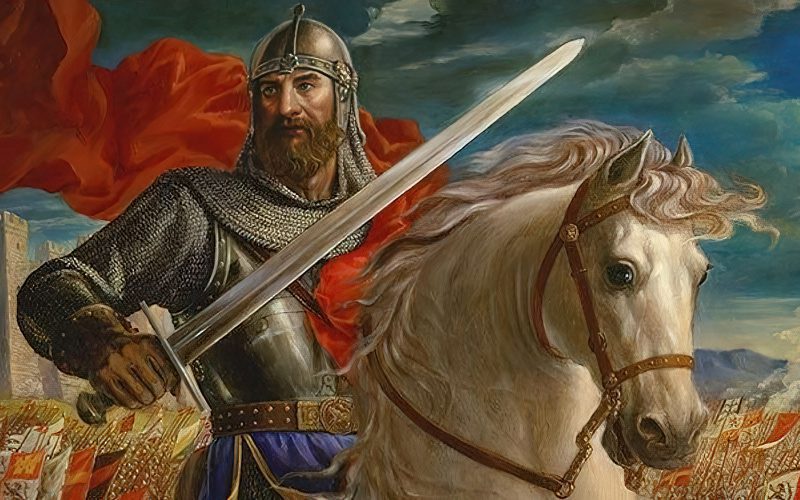
What’s in this article?
El Cid Campeador, or the valiant Spanish knight El Cid, is said to have had two swords named Colada and Tizona which he used in his many military conquests. They have seen many battles and brought him many victories throughout the middle ages.
In this article, we will discuss the Colada and Tizona swords and go a little bit more in-depth about their characteristics and looks. We shall explain who El Cid actually was, go over the specific uses of these swords, and finish up with their legendary history.
Who was El Cid?
Rodrigo Dáz de Vivar was a Castillian knight who attained a great deal of notoriety due to his service and participation in the forces of both Muslim and Christian kings. After his death, El Cid became a revered national hero of Spain. He was also the protagonist of the famous medieval Spanish epic poem, El Cantar de Mio Cid. This poem portrayed him as the ideal medieval knight by showing him as strong, courageous, loyal, righteous, and holy.
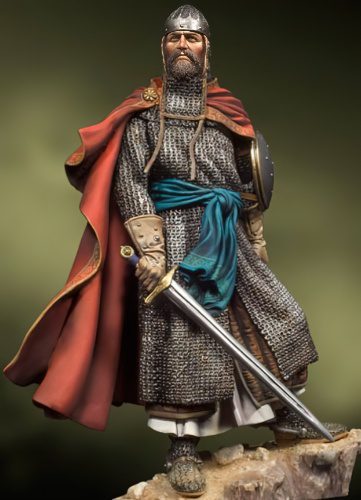
At the end of the 11th century, he came to rule the region of the Iberian Peninsula known as Levante thanks to his leadership and a large number of devoted knights. During the short time that Valencia was under Moorish rule during the Reconquista, he was able to recapture its immensely important territories.
Thanks to his many many military conquests, he was given the honorific title of El Cid, which in Spanish means The Lord. He ruled Valencia from 1094 to 1099, and although much of his family history is a mystery, El Cid is still revered as a folk hero and a symbol of Spain’s national identity. His life and exploits are often recounted and celebrated in Spanish culture to this day.
Tizon or Colada?
El Cid probably had many swords that he used throughout his life, but the most common ones found in literature are Colada and Tizon.
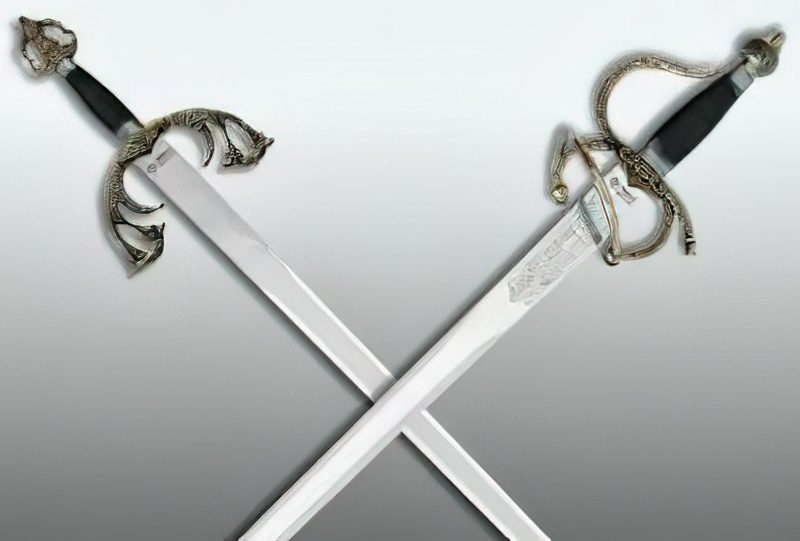
Tizon directly translates to firebrand or was a generic term for a sword in the late middle ages of Spain. Colada directly translates to cast or stainless steel, or a steel blade that has no impurities. The main differences between the two swords are the guard and handle. The Colada has a guard and handle commonly found during the renaissance period, about 5 centuries after the life of El Cid.
This time period discrepancy in the guard of the Colada often led to people doubting its authenticity. The Tizon is perhaps closer to the original and authentic El Cid’s sword. Bards of this period liked to create tales of a legend that were not at all founded on historical facts. Colada may have been a popular legend passed down through the ages and not have been actually used by El Cid.
Characteristics of El Cid’s Sword

Tizona del Cid is the sword that was carried by the valiant knight El Cid in 11th-century Spain. It has very medieval-like characteristics similar to that of an arming sword. The most unusual thing about it is the guard, which is often thought to have been added later on in history.
Blade
The blade of El Cid’s sword is straight and double-edged. It can be used to slash or thrust at enemies. It looks just like a typical Arming sword used in medieval times, and it is very similar to Oakeshott’s XIII sword. It ends in a sharpened point that could easily penetrate leather armor or bare skin.
The overall length of the blade on El Cid’s sword, Tizona, was around 31 inches long (79 cm), which was perfectly similar to an Arming sword from the same period.
Along the spine, or the middle of the blade, there is a fuller that runs a little less than half of the sword, The fuller is meant to both stiffen and lighten the blade. Perhaps the most interesting thing about the Tizona is the inscriptions along the blade itself.
Inscriptions
If you look closely at El Cid’s Sword, you will notice that there are two sets of inscriptions etched with acid on each side of the blade. They next to the fuller, and say:
- I am the Tizona, who was made in the year 1040
- Hail Mary, full of grace, the Lord be with me
Historians believe that these inscriptions were added much later to the sword. Some have traced their origins to the 13th and 14th centuries, just a little over 200 years after the life of El Cid. The term Tizona also confirms this because the earliest reference or use of the word ‘Tizona’ is from the 14th century.
Guard
The guard of El Cid’s sword is an elaborate, curved hybrid form of Hispano-Moorish guards. The Tizona had a new guard installed during the period of the Catholic Monarchs – a time in history at the end of the 15th century during which Spain saw a lot of progress.
The non-authentic guard has the crossguards pointing at the blade with many smaller quillons. The original guard could have just had a typical medieval straight crucifix crossguard, which was common for the time.
Colada
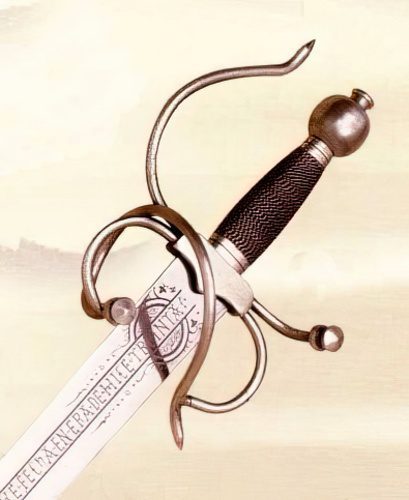
The Colada has a much later, almost Renaissance style guard with the many quillons that form a protective circle for the user’s hand. This style of guard can easily be traced to the Side sword. The Side sword came about 4 to 5 centuries later after El Cid’s time period.
Handle
El Cid’s sword has a straight handle that is very similar to the classic medieval Arming sword. The length of Tizona’s handle and pommel is around 4.7 inches long (12 cm).
Pommel

El Cid’s sword has a round pommel with an opening on each side. It was meant to decorative to honor the legendary warrior El Cid. It is possible that it was added to the sword around the same time that the guard was added.
Size & Length
El Cid’s sword was designed and smithed in a similar style as a medieval Arming sword. The overall length is 36.8 inches (93.5 cm). This was the ideal length for a one-handed sword that was meant to be used with a shield.
Some say the Colada was El Cid’s two-handed sword, but facts say otherwise. The main reason is that there are no known two-handed swords from 11th century Spain. The earliest two-handed swords from Spain are dated to the 13th century.
Weight
The Tizona sword weighs a total of 2.5 lbs (1.15kg). This was a common weight for Arming swords. They were light enough to be swung with ferocity without tiring the user out. They also were heavy enough to deal considerable damage to opponents or shields.
Uses of El Cid’s Sword
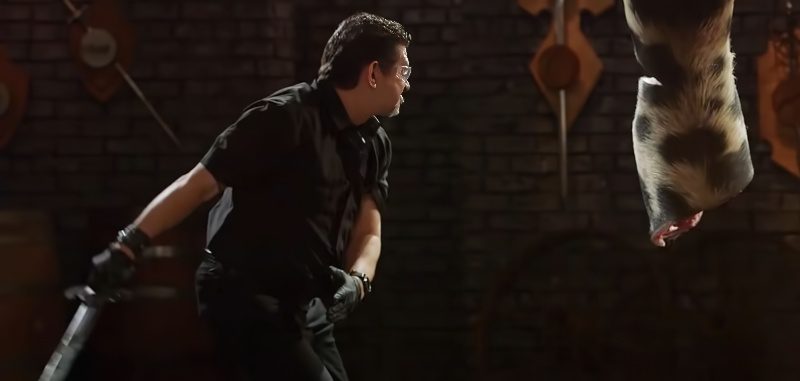
El Cid’s sword is a double-edged sword with a pointed tip. This means that it can be used both for thrusting and slashing. The size of the weapon means that it is powerful enough to be used as a one hand sword only, but it can be devastating when used with both hands. It feels and looks just like a medieval Arming sword does, except for the Moorish-styled guard.
Warfare
The biggest use that El Cid’s sword had was warfare. El Cid himself was known to actively participate in battles and lead his trusted troops in many dangerous scenarios. Since El Cid owned many swords, it is questionable whether this is the exact sword he used. El Cid most likely used a similar style sword in combination with a shield on horseback.
Legendary
The second biggest use, and most likely the strongest, is the legendary power that this sword had. This primarily comes from Cantar de Mio Cid, which translates to The Poem of Cid. This poem is the oldest and most well-preserved Castillian poem that tells the tales of El Cid.
Some legends state that the Tizona was so powerful that whenever it was held in someone’s hands, it would glow very bright and make all their foes and enemies run away in fear. It’s said that El Cid would even give the sword away as a present, but it would always somehow find its way back to him.
Modern

Today, El Cid’s sword plays a significant role as a symbol of history and legend in Spain. It is a well-preserved sword and kept in a museum so that the stories of El Cid might be shared with tourists about his bravery and valor.
This sword is commonly seen in reenactments or media like movies, TV, and anime portraying 11th century Spain. More often than not, the Tizona is a sword that is linked much more to El Cid rather than the Colada.
History of El Cid’s Sword
El Cid was a Spanish/Castillian warrior and knight that lived in the 11th century. The origin of El Cid’s sword and history should come from this period of time, but many modern historians argue that the sword we have today isn’t a real sword used by El Cid.

The problem is that after the 11th century, there are hardly any mentions of it outside of select literature. There was a sword named Tiso that James I of Aragon owned, but it doesn’t seem to have any similarities to El Cid’s sword. This also seems to mean that ‘Tizon’, or firebrand, was a generic term for a sword and not the name of El Cid’s sword.
Its history can be traced back to the start of the 16th century, when Martin I, King of Aragon, had a sword with such a name in his armory. Later, at the end of this century, Fernando the Catholic gave the weapon to Mosen Pierres de Peralta, Marquis of Falces, as a reward and compensation for his services.
Already at that time, it was connected to El Cid, so it was seen as a very valuable and important piece. But if this were the case, it would have been valuable in the centuries prior too.
So, the Marquises of Falces kept it until the middle of the 20th century, when they gave it to the Army Museum in Toledo. After a period of time, the Junta de Castilla y León and the Chamber of Commerce and Industry of Burgos bought it in 2007 for 1.6 million euros so that it could be shown in the Museum of Burgos today. Even with that price tag, it’s history still remains questioned today.
Is the Sword in Burgos the Real El Cid Sword?
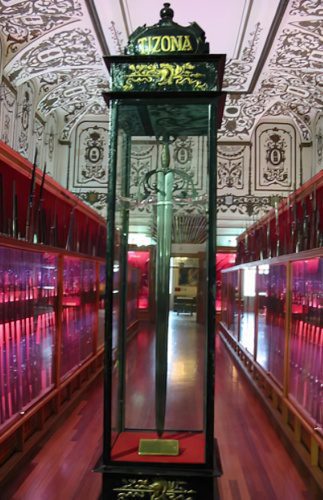
When we consider El Cid’s sword and its connection to the historical character Rodrigo Diaz de Vivar, the situation gets very unclear. Although he likely had more than one sword, the few documents that survived from the time of Don Rodrigo’s life do not reference which swords he owned.
The earliest reference comes from the Poem of El Cid, which was written around a century and a half after he had passed away. Because of this, it is impossible to determine who the first owner was; nonetheless, it is possible to claim by some people that the particular Tizona in Burgos museum is the one that has been spoken about in fables and ballads of epic proportions.
What we can say for certain is that the guard and handle are definitely not from El Cid’s period as they are gothic and originate in the late 15th century. When the blade comes to question, there are many studies that link the strong steel blade to the craft of Andalusian blacksmiths who were known throughout history for their excellent skills.
Some, especially Menéndez Pidal a Spanish historian with a nomination for the Nobel prize, say that it is a 16th-century forgery that was meant to give Spain legitimacy, power, and prestige. Others, like Bruhn de Hoffmeyer, a Danish medieval weapons expert, say that the sword might actually be real.
Conclusion
Today, El Cid’s sword is one of the most interesting historical swords and has been linked with many folk literature and poems. It perfectly fits inside the group of famous swords like Charlemagne’s Joyeuse, King Arthur’s Excalibur, and many more.




